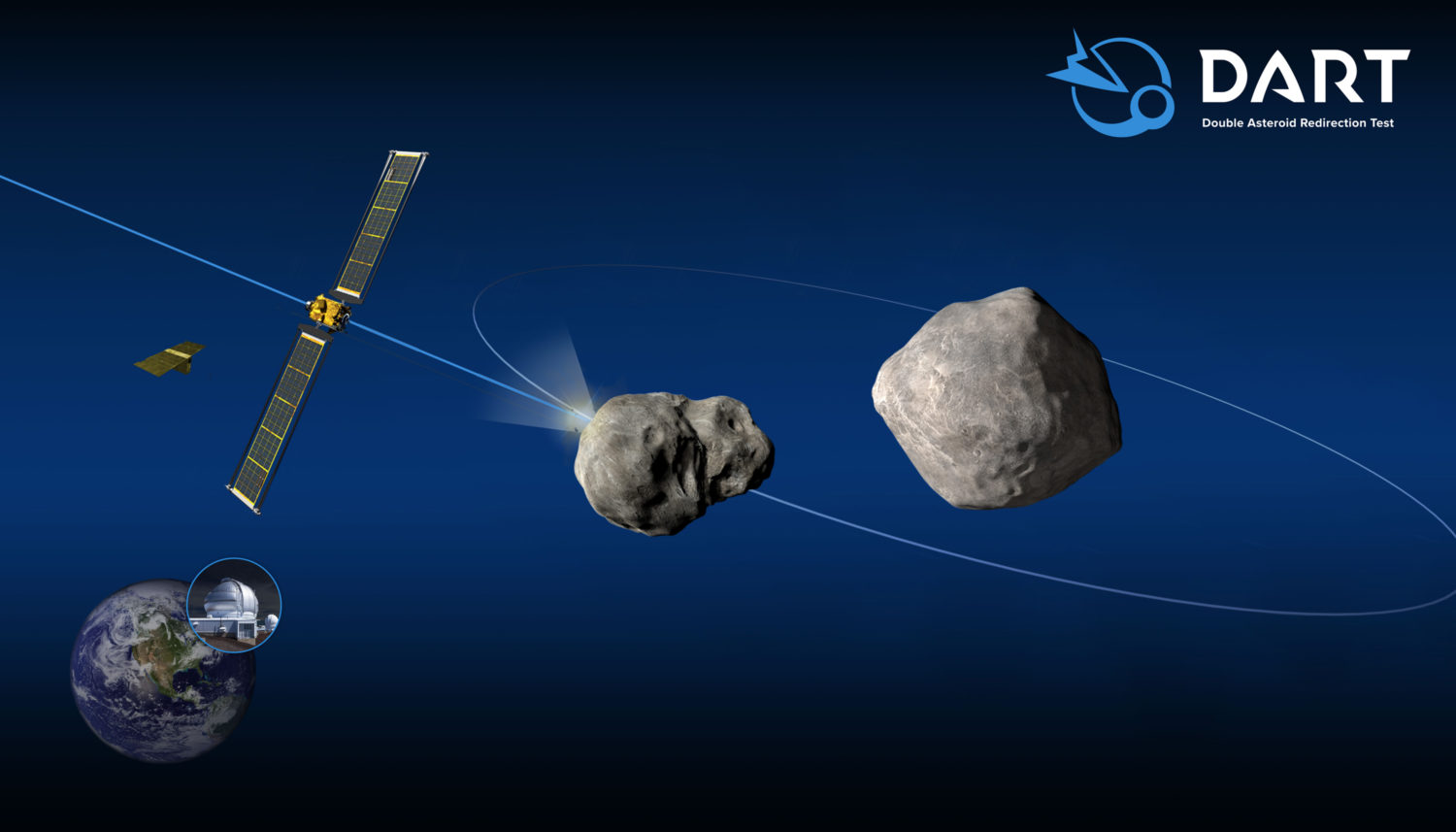
Janus asteroid mission will open a new class of lower-cost space exploration
Artist’s conception shows NASA’s upcoming Double Asteroid Redirection Test (DART) mission, a planetary defense-driven test of technologies for preventing an impact on Earth by a hazardous asteroid. (Image courtesy of NASA/Johns Hopkins Applied Physics Lab)
Missions will take close-ups of binary asteroids and a metal asteroid that may be the core of an early planet.
The Janus dual space probe that launches next year on a mission to unravel the evolutionary mysteries of two binary asteroids carries a price tag that’s less than one-tenth the cost of other future NASA missions, paving the way for a new class of lower-cost space exploration, according to a space expert at the University of Colorado Boulder.
Daniel Scheeres, distinguished professor of aerospace engineering at CU Boulder, spoke Oct. 5 to science writers attending the ScienceWriters2021 virtual conference as part of the New Horizons in Science briefings organized by the Council for the Advancement of Science Writing (CASW).
Scheeres discussed the latest asteroid science and gave updates on several space missions in the offing.
“The one that I’m probably most partial to and interested in is the Janus mission. This launches in August of 2022, but we’re ridesharing… [Janus] goes along with the Psyche Mission,” which will explore the Psyche 16 asteroud, Scheeres said.
Janus will fly by two different binary asteroids, he said.
“We actually send up two spacecraft; each spacecraft flies by a different binary asteroid and takes a bunch of images of them as we fly by. So this is one of those drive-by missions,” the scientist explained.
Scheeres said the Janus mission will be a little more complicated than previous asteroid missions.
“It’s a new class of mission by NASA called the SIMPLEx missions. And the cost of these missions is less than 10 percent, probably much less than 10 percent, of things like Lucy and Psyche and the like. And, so it’s a new idea for developing and flying missions,” he noted.
“If we’re successful—and we believe, of course, that we will be—we’ll actually open up a new class of lower-cost exploration that is very well tuned for the small bodies, the asteroids in the solar system,” Scheeres added.
Janus is a joint project between NASA, CU Boulder, Lockheed Martin, and Malin Space Sciences Systems, which is providing the instrumentation.
Scheeres noted that although both of these asteroids have been observed before, making them great targets, they haven’t been seen up close.
“What our mission is going to do is to take the existing knowledge we have of these two binary asteroids, and then get a bunch of close-up images of them,” Scheeres noted.
He said there are some key scientific questions that the mission will address: for example, how “rubble pile” asteroids evolve over time, how binary asteroids get formed, what properties these microgravity aggregates have, and the possibility of modeling the complex and unique dynamical systems of these binary asteroids as they’re interacting with each other.
A rubble pile is a celestial body consisting of numerous pieces of rock that have coalesced under the influence of gravity.
“Both of these asteroids are also potentially hazardous asteroids as well, which adds a little more interest to the whole thing,” he explained.
Giving an overview of other future asteroid missions, Scheeres said NASA’s Lucy spacecraft is set to launch this month on a 12-year journey to the Jupiter trojan asteroids. Trojan asteroids are bodies that share a solar orbit with a planet.
Lucy will be the first spacecraft to visit these trojans, named after characters from Greek mythology, and the first to examine so many independent solar system targets, each in its own orbit around the sun.
“Taking the observation from these asteroids will help understand some very fundamental aspects of them,” Scheeres said.
Another upcoming mission is the Double Asteroid Redirection Test (DART), a planetary defense-driven test of technologies for preventing an impact of Earth by a hazardous asteroid.
DART, which will be launched in late November, is NASA’s first planetary defense mission, Scheeres noted.
“It will actually be a test of the deflection approach that we have hypothesized could work to nudge hazardous asteroids coming towards the Earth out of the way,” he explained.
Another exciting mission, Scheeres added, will journey to a unique metal asteroid, Psyche 16, orbiting the Sun between Mars and Jupiter.
What makes Psyche 16 unique is that it appears to be the exposed metallic core of an early planet. The Psyche mission is scheduled to launch in August 2022 and arrives at the asteroid in 2026.